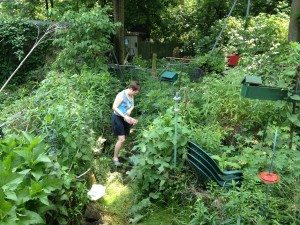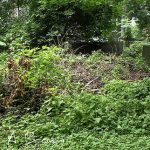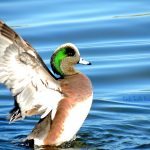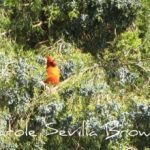I am in the process of ripping my whole wildlife garden out so that I can start over again because invasive plants have taken over and it’s easier to just start from a blank slate to clear away these invasive thugs. Last year was a difficult year and I was away for several months at a time, and during this time my wildlife garden was sadly neglected, allowing these invasive plants to gain an unrelenting foothold in my garden.
You may need to start over for any number of reasons:
- A fallen tree turns a formerly shaded site into a spot that now gets full sun
- Construction and repairs to your home
- Neglect
- You’re new to the concept of wildlife gardening and are eager to create welcoming habitat for wildlife in your garden
When faced with one of these opportunities, it’s important to make a plan before you start. Making a plan will ultimately save you a lot of time and even money as you ensure that you’re choosing the best plants for wildlife and placing them in the right place for the conditions in your garden.
Removing an overgrown wildlife garden can seem like a daunting task, especially if it’s filled with invasive plants. But with a little bit of planning and effort, you can start fresh and create a new, healthier garden that’s better suited to the local wildlife.
Here are some tips to help you get started:
- Assess the situation: Take a close look at your garden and identify the invasive plants that are taking over. Make a list of these plants and research how they spread so you can plan your removal strategy.
- Be strategic: When removing invasive plants, it’s important to work in stages to prevent the spread of seeds and roots. Start with one area at a time, removing the invasives and any associated plant material.
- Dig deep: For tough invasive plants, you may need to dig down and remove as much of the root system as possible. This can be hard work, but it’s essential for preventing the plant from regrowing.
- Use the right tools: A sturdy digging fork and a good pair of gloves are essential tools for removing invasive plants. You may also need a pruning saw or loppers to cut back large shrubs or trees.
- Dispose of plant material properly: Once you’ve removed the invasive plants, don’t just toss the plant material in your compost pile or leave it on the ground. This can spread seeds and regrow the invasive plants. Instead, bag the material and dispose of it in a landfill.
- Plan your new garden: Once the invasive plants are gone, it’s time to start planning your new wildlife garden. Choose native plants that are well-suited to your local climate and soil, and arrange them in a way that provides food, shelter, and nesting opportunities for a variety of wildlife species.
Starting from scratch with a wildlife garden can be a lot of work, but it’s also a rewarding experience. With a little patience and perseverance, you’ll be well on your way to creating a beautiful, healthy garden that’s a haven for wildlife.
More From Ecosystem Gardening:
Submit your review | |








